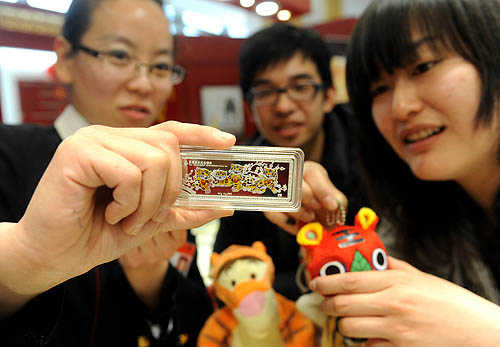|
 |
|
GO FOR THE GOLD: A customer looks at gold products in Beijing. Gold has become a popular item for gift giving during the Spring Festival holiday |
Beijing housewife Jian An and her family spent 8,563 yuan ($1,260) during the Spring Festival holiday (February 13-19), which was even higher than her monthly earnings. And half of the spending went on a new digital camera. "It is reasonable because the Spring Festival—the Chinese Lunar New Year—is the most important festival of the year," Jian said.
Jian's holiday spending was far from being called lavish or luxurious—it actually falls at an intermediate level among her friends. "One of my friends spent nearly 20,000 yuan ($2,941)," said Jian.
According to the Ministry of Commerce, China realized retail sales on consumer goods of 340 billion yuan ($50 billion) during the seven-day holiday, a robust increase of 17.2 percent year on year.
Traditional festival goods, including food, beverages, catering, liquor, tobacco, fireworks, jewelry, clothing and household appliances all witnessed a rapid surge in sales, said the ministry. Shoppers also took to the Internet in search of deals. Hangzhou-based Taobao.com, the biggest online shopping website in Asia, from February 14 to 17, scored business volume of 1 billion yuan ($147 million).
While family reunions enjoyed priority among the multitude of Spring Festival traditions, a growing number of Chinese people used the holiday as an opportunity to travel. The National Tourism Administration said spending on tourism reached 208 million yuan ($30.6 million), a year-on-year increase of 23.1 percent.
Whether the holiday spending spree will start a new surge in consumption for the rest of the year, however, is uncertain.
A holiday frenzy
"Although consumer goods sales [during the Spring Festival] were at a record high this year, we cannot tell if it would drive the economic growth in a real sense," said Cai He, a sociology professor at Guangzhou-based Sun Yat-Sen University.
"People who are not willing to spend or dare not spend normally all buy things for the festival," said Cai. "It is a tradition for the Chinese, rich or poor." In this sense, the Spring Festival market surge is bound to happen annually.
While income remains unchanged, the soaring Spring Festival spending will undermine post-holiday consumption since the consuming capability of people has been overdrawn by the short holiday, Cai said.
This year's growth rate for gross retail sales of consumer goods might be a little lower than that of 2009, said Fan Jianping, a senior analyst at the State Information Center, a key government think tank. The effects of government stimulus measures on consumption this year will gradually decrease as a result of a sudden spending boom last year, Fan said.
Wang Yuehun, chief economist of MasterCard Asian-Pacific, agreed with Fan. The explanation for the consumption surge last year is simple—government subsidies provided the necessary boost, Wang said. "Obviously, it is not sustainable."
Meanwhile, the lack of income growth to push forward consumption in a sustainable manner could also harm future spending sprees. "As we all know, consumption is decided by income, and the much slower income growth compared with consumption last year will make the consumption increase this year lack momentum, said Zhou Xiaozhi, Deputy Director of the research department at China Construction Bank.
In 2009, China realized gross retail sales of consumer goods of 12.5 trillion yuan ($1.83 trillion), an increase of 15.5 percent year on year. By sharp contrast, the per-capita disposable income for urban residents increased by only 9.8 percent. Rural residents' income increased 8.5 percent, said the National Bureau of Statistics (NBS).
| 